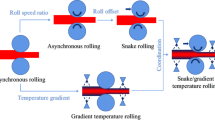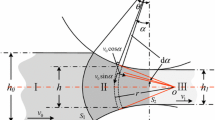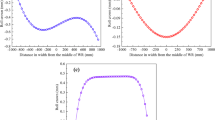Abstract
The temperature gradient rolling (GTR) method effectively addresses the issue of uneven deformation of surface and core in the rolling of extra-thick plate. Different from the traditional near uniform temperature rolling (UTR) process, GTR involves a significant temperature gradient along the thickness direction of the rolled piece. As a result, the rolling force prediction model used in uniform temperature rolling cannot be directly applied in GTR. Rolling force prediction model is crucial for process control models of plate mill and serves as the foundation for plate thickness control. However, there has been limited research on rolling force prediction methods specifically for GTR. In order to predict the change of rolling force in GTR process and enhance the control of the rolling process, the current paper proposed a simplified method based on the deformation resistance model, temperature distribution fitting, differential method, and loop iteration. The precision of the method was examined by using a finite element model and plane strain experiment, demonstrating a mean error between the method and FEM was less than 5%.










Similar content being viewed by others
Data availability
The models used in the current study can be provided from the appropriate authors according to reasonable requirements.
References
Wei Y, Gaosheng L, Qingwu C (2015) Effect of a novel gradient temperature rolling process on deformation, microstructure and mechanical properties of ultra-heavy plate. J Mater Process Technol 217:317–326. https://doi.org/10.1016/j.jmatprotec.2014.11.011
Wei Y, Gaosheng L, Qingwu C (2015) Q345 ultra-heavy plate rolled with temperature gradient. Mater Manuf Process 30(1):104–110. https://doi.org/10.1080/10426914.2014.952039
Gaosheng L, Wei Y, Qingwu C et al (2017) Effect of gradient temperature rolling (GTR) and cooling on microstructure and properties of E40-grade heavy plate. Arch Civ Mech Eng 17(1):121–131. https://doi.org/10.1016/j.acme.2016.09.004
Li S, Wang Z, Liu C et al (2016) A simplified method to calculate the rolling force in hot rolling. Int J Adv Manuf Technol 1-7. https://doi.org/10.1007/s00170-016-8890-z
Li W, Chao LIU, Ning F et al (2016) Friction estimation and roll force prediction during hot strip rolling. J Iron Steel Res Int 23(12):1268–1276. https://doi.org/10.1016/S1006-706X(16)30187-X
Cao J, Liu Y, Luan F et al (2016) The calculation of vertical rolling force by using angular bisector yield criterion and Pavlov principle. International Int J Adv Manuf Tech 86(9-12):2701–2710. https://doi.org/10.1007/s00170-016-8373-2
Zhang DH, Liu YM, Sun J et al (2016) A novel analytical approach to predict rolling force in hot strip finish rolling based on cosine velocity field and equal area criterion. Int J Adv Manuf Technol 84(5-8):843–850. https://doi.org/10.1007/s00170-015-7692-z
Guo ZY, Sun JN, Du FS (2016) Application of finite element method and artificial neural networks to predict the rolling force in hot rolling of Mg alloy plates. J South Afr Inst Min Metall 116(1):43–48. https://doi.org/10.17159/2411-9717/2016/v116n1a7
Kim YK, Moon CH, Hwang SM (2011) A finite element-based on-line model for the prediction of roll force and roll power in a round-oval-round pass rolling sequence. Proc Inst Mech Eng B J Eng Manuf 225(6):891–900. https://doi.org/10.1243/09544054JEM2040
Lin JC (2002) Prediction of rolling force and deformation in three-dimensional cold rolling by using the finite-element method and a neural network. Int J Adv Manuf Technol 20(11):799–806. https://doi.org/10.1007/s001700200219
Wang HY, Ding JG, Lu X et al (2017) Analysis of ultra-heavy plate rolling force based on thickness temperature gradient elements and experiment simulations. Proc Inst Mech Eng C J Mech Eng Sci 231(4):599–615. https://doi.org/10.1177/0954406215622497
Schindler I, Kliber J, Bořuta J (1988) Predictive model for deformation resistance in rolling based on torsion parameters. J Mater Sci Technol 4(4):354–360. https://doi.org/10.1179/mst.1988.4.4.354
Siciliano F, Imagumbai M (2003) Effect of microalloying on hot-deformation resistance during rolling. In: In Materials Science Forum, vol 426. Trans Tech Publications, pp 1605–1610. https://doi.org/10.4028/www.scientific.net/MSF.426-432.1605
Dobatkin S, Zrnik J, Mamuzić I (2009) Mechanical and service properties of low carbon steels processed by severe plastic deformation. Metalurgija 48(3):157–160 https://www.scopus.com/inward/record.uri?eid=2-s2.0-70649104061&partnerID=40&md5=c84b0eff84f75c5611dd696d35623f36
Chen QJ, Kang YL, Hong HP et al (2005) Simulation of rolling process for wide and thin plate of alloy steel by finite element method. J Plast Eng 12(Z1):163–167. (in Chinese). https://doi.org/10.3969/j.issn.1007-2012.2005.z1.038
Pan HB, Tang D, Hu SP et al (2008) Development of large specimen multi-deformation plane strain thermo-mechanical simulator. Mach Design & Manuf 9:101–103. (in Chinese). https://doi.org/10.3969/j.issn.1001-3997.2008.09.042
Acknowledgements
Thanks are extended to the guidance of Master Li Goldman and the teachers of the laboratory of the Institute of Engineering and Technology, University of Science and Technology Bei**g.
Funding
This work was financially supported by the National 13th Five-Year Key R&D Plan (project number: 2017YFB0304602).
Author information
Authors and Affiliations
Contributions
Zhang Yu: data analysis and writing
Yu Wei: formal analysis
Cheng Zhicheng: visualization
Cai Qingwu: validation
Corresponding author
Ethics declarations
Ethical approval
Written informed consent was obtained from the tester (one of the authors) and all authors.
Conflict of interest
The authors declare no competing interests.
Additional information
Publisher’s Note
Springer Nature remains neutral with regard to jurisdictional claims in published maps and institutional affiliations.
Rights and permissions
Springer Nature or its licensor (e.g. a society or other partner) holds exclusive rights to this article under a publishing agreement with the author(s) or other rightsholder(s); author self-archiving of the accepted manuscript version of this article is solely governed by the terms of such publishing agreement and applicable law.
About this article
Cite this article
Zhang, Y., Yu, W., Cheng, Z. et al. Accurate prediction algorithm of rolling force in slab gradient temperature rolling process. Int J Adv Manuf Technol 129, 671–679 (2023). https://doi.org/10.1007/s00170-023-12236-w
Received:
Accepted:
Published:
Issue Date:
DOI: https://doi.org/10.1007/s00170-023-12236-w




